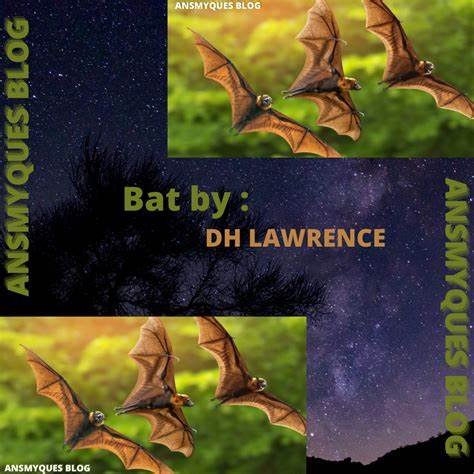Introduction
D.H. Lawrence’s poem “Bats” explores the theme of the natural world, particularly the life of bats, through vivid imagery and a symbolic lens. Written in 1929, the poem reflects Lawrence’s deep fascination with the relationship between humanity and nature. In his characteristic style, Lawrence draws connections between the animal world and human emotions, using the bat as a metaphor for broader themes of freedom, isolation, and transformation.
Text of the Poem: “Bats”
The bats are gone into the sky,
And the cold light is falling fast,
I am glad to be alone
And to hear the soft stirring of the bats’ wings
Faintly on the air.
Analysis of the Poem
- The Bats as Metaphors for Freedom and Isolation
At first glance, the poem presents the bats simply as creatures of the night, retreating into the sky. However, Lawrence imbues the bats with symbolic significance. The bats’ flight into the sky may symbolize freedom, suggesting that they are untethered by earthly constraints. This contrasts with the human condition, which often feels weighed down by society or emotions. At the same time, the phrase “cold light is falling fast” suggests a sense of isolation and melancholy, as the bats are moving away from human awareness. This duality of freedom and loneliness is a recurring theme in Lawrence’s work, and in this poem, the bats seem to represent the tension between these two aspects of existence. - The Poem’s Atmosphere: Quiet and Reflective
Lawrence’s choice of words and tone creates a reflective atmosphere. The use of phrases like “cold light” and “faintly on the air” gives the scene a calm, almost haunting quality. The poem invites the reader to slow down and observe, much like the speaker does as they watch the bats take flight. There is a contemplative mood in the poem, emphasizing the quietness of nature and the solitude that accompanies the passage of time. - The Coldness of the Light
The reference to “cold light” is significant, as it conveys a sense of detachment and emotional distance. The light, instead of being warm or comforting, is cold, which can be interpreted as representing a disconnection from the natural world or from others. This coldness could also imply the inevitability of change, as night takes over, and the bats disappear into the darkness. The “cold light” serves as a reminder of the transient nature of both life and the natural world. - Sound and Silence
The bats’ wings are described as “faintly on the air,” emphasizing the quiet and subtle sounds of nature. This contrasts with the noisy, chaotic human world. The soft stirring of the wings could symbolize the fleeting nature of existence itself—something barely perceptible but constant. The speaker seems to take solace in the gentle sounds of the bats’ flight, perhaps finding a kind of peace in the fleeting, quiet moments of life. - Human Connection to the Natural World
Lawrence often explored the idea that humans are disconnected from the natural world, and “Bats” subtly touches on this theme. The bats are described as moving freely in the sky, while the speaker remains grounded. This creates a sense of separation, implying that humans often long for the kind of freedom and detachment that animals, like the bats, possess. Yet, this freedom comes with a form of isolation, which is also symbolized by the bats’ retreat into the night.
Themes in the Poem
- Freedom vs. Isolation
The bats’ flight into the sky represents freedom, but this freedom also results in their separation from the speaker. This duality—freedom leading to isolation—is a central theme in the poem, reflecting the human struggle between the desire for liberation and the loneliness that often accompanies it. - Nature’s Beauty and Transience
The poem captures a moment in time when the bats leave, and the light fades. This transience in nature is mirrored in the fleeting moments of human life. Lawrence often pondered the impermanence of all things, and the bats’ flight symbolizes the passing of time and the ephemeral nature of beauty in the natural world. - Solitude and Self-Reflection
The speaker’s feeling of being “glad to be alone” suggests that solitude is a space for reflection. In this quiet moment, the speaker is able to connect with the natural world, but this connection also brings forth the isolation of being alone. This solitude could be seen as both a retreat into oneself and a means of gaining clarity. - Connection with the Animal World
Lawrence’s poem encourages the reader to consider their relationship with animals and the natural world. The bats’ flight is not just an image of nature but a prompt for the speaker—and the reader—to reflect on their own existence in relation to the larger world. The bats seem to move in harmony with the environment, which serves as a contrast to human alienation from nature.
Class Activities
- Symbolism of the Bats
Have students discuss what the bats represent in the poem. How do the bats’ actions and the imagery surrounding them relate to themes of freedom, isolation, or transformation? Encourage students to draw parallels between the bats and human experiences. - Imagery and Mood Exploration
Ask students to identify the key images in the poem (e.g., “cold light,” “faintly on the air”) and discuss how these images contribute to the overall mood. What emotional response does the poem evoke through its imagery? - Poem Recitation and Sound Study
Have students recite the poem aloud, paying special attention to the sounds of the words, such as the soft “faintly” or the harshness of “cold light.” Afterward, discuss how Lawrence’s use of sound affects the poem’s meaning and atmosphere. - Nature and Human Connection Discussion
Engage students in a discussion about humanity’s relationship with the natural world. How do humans relate to nature in “Bats”? How might the poem reflect concerns about the environment or human disconnect from nature? - Writing Exercise: Nature’s Transience
Ask students to write a brief poem or reflection about the fleeting nature of something in their own lives—whether it be a moment, a season, or an experience. Encourage them to use imagery similar to Lawrence’s to capture the beauty and brevity of the subject.
Class Assignments
- Essay on the Theme of Freedom and Isolation
Write an essay analyzing how the poem portrays the themes of freedom and isolation. How do the bats symbolize both freedom and separation, and what message does the poem convey about these dualities? - Research Paper on D.H. Lawrence’s View of Nature
Conduct research on D.H. Lawrence’s views on nature and write a paper exploring how these views are reflected in “Bats.” Consider how his personal experiences with nature influenced his writing. - Comparative Analysis with Other Poems
Compare “Bats” to another poem by D.H. Lawrence, such as “Snake” or “The Cat,” focusing on similar themes like the human relationship with animals and nature. How do these poems share common motifs or ideas? - Creative Writing Assignment: Nature and Human Emotion
Have students write a short story or poem inspired by the natural world, focusing on how animals or nature might reflect human emotions. Encourage them to explore the symbolic possibilities of nature, similar to how Lawrence uses the bats. - Discussion Paper on Solitude in Poetry
Write a discussion paper analyzing the theme of solitude in poetry, with “Bats” as a primary example. How do poets like Lawrence use solitude to explore broader human themes, and what insights does “Bats” offer on this concept?
Conclusion
In “Bats,” D.H. Lawrence encapsulates the beauty and complexity of the natural world through the metaphor of bats taking flight into the night sky. Through rich imagery and symbolism, the poem explores themes of freedom, isolation, and the fleeting nature of life. The bats, as symbols of freedom and detachment, prompt reflection on the human desire for connection with the natural world, while also highlighting the loneliness that can accompany such freedom. Lawrence’s subtle exploration of these themes offers a timeless meditation on the paradoxes of existence.

